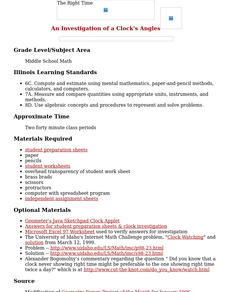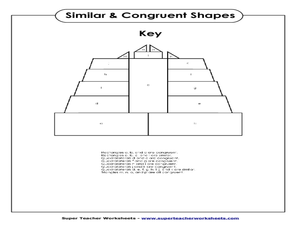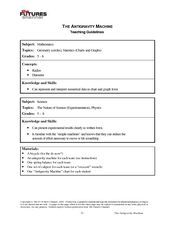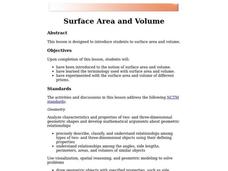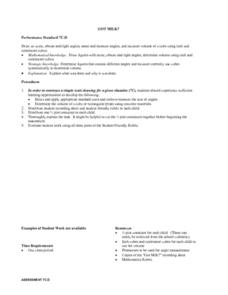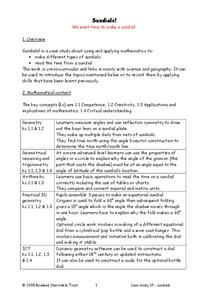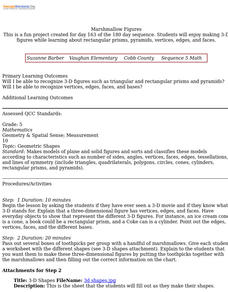Curated OER
Properties of Triangles
Students explore the relationship between how big a side of a triangle is and how big its opposite angle is by creating triangles using an interactive website.
Curated OER
Multiple Images Activity
In this images worksheet, students use different sized mirrors to determine how many angles and images are reflected. Students complete 5 sets of directions.
Curated OER
Polygons
In this polygon instructional activity, students draw various polygons according to given specifications and find angle sums. A website reference for additional resources is given.
Curated OER
Weather Tools
Students explore Earth science by participating in a weather identification activity. In this scientific instrument instructional activity, students identify several weather related tools such as the weather vane, thermometer and rain...
Curated OER
Getting it Right!
Students investigate error. As shown in earlier activities from navigation lessons 1 through 3, without an understanding of how errors can affect position, one cannot navigate well. Students explore how computers can help in navigation....
Curated OER
Rainbow Jelly
Students work with teaspoons, tablespoons and fractions of a cup to make their own rainbow jelly, converting between units of volume as required. They recognize the need for a standard unit of volume and measure volume using teaspoons...
Curated OER
The Right Time
Students compute and estimate using mental mathematics, paper-and-pencil methods, calculators, and computers. They measure and compare quantities using appropriate units, instruments and methods. They utilize worksheets imbedded in this...
Curated OER
Similar and Congruent Shapes
In this similar-congruent worksheet, students determine measures of unknown angles, draw congruent shapes and determine whether shapes are congruent. A reference web site is given for additional activities.
Curated OER
Surveying: 19 Chains and 50 Links
Through an interdisciplinary lesson, emerging engineers explore the history of surveying systems. After discussing various systems, they perform surveys on printable pages. Using their geometric skills, they physically stake out plots...
Curated OER
The Anti-Gravity Machine
Learners examine physics by completing a bicycle experiment in class. In this gravity instructional activity, students measure the characteristics of different bicycles and compare their different race times. Learners utilize a...
Curated OER
Length, Perimeter, and Area
Students explore the concepts of length, perimeter and area. Students develop an understanding of length, perimeter, and area. Students calculate the area and perimeter of random shapes and calculate the area and perimeter of a triangle...
Curated OER
Surface Area and Volume
Learners are introduced to the notion of surface area and volume. Students review surface area and volume by finding the area of a two-dimensional shape. They practice using the computer to create different surface area shapes.
Curated OER
Got Milk?
Learners measure the angles of a milk carton. They identify and label acute, right, and obtuse angles. Using appropriate tools, students determine the volume of a cube or a rectangular prism. Learners complete worksheets to...
Curated OER
Symmetry and Tessellations
Sixth graders investigate tessellations and their origins. Students trace triangles to form a tessellation. They measure the angle of equilateral triangles. Students locate the line of symmetry, they create geometric squares,...
Curated OER
Angles, Parallel Lines, and Polygons
Students examine how to investigate polygons using an instrument of their own construction. They should be able to prove the general formula for the number of degrees in any polygon (including a triangle). Finally they investigate an...
Curated OER
Sports and Geometry
Students investigate shapes in sports. In this geometry lesson, students identify geometric shapes in sports equipment, fields, etc. Students present their findings.
Curated OER
Hands On: Construct Triangles and Rectangles
In this congruent triangles and rectangles worksheet, students solve 6 word problems where they identify whether triangles and rectangles are congruent, and construct triangles. Students must explain their reasoning and prove each answer.
Shodor Education Foundation
An Introduction To Quadrilaterals
Young geometers investigate and apply properties of quadrilaterals. After a review and discussion of key terms, young scholars use a computer applet to explore four-sided figures and classify them according to their attributes. The...
Bowland
Sundials!
Time to learn about sundials. Scholars see how to build sundials after learning about Earth's rotation and its relation to time. The unit describes several different types of possible sundials, so choose the one that fits your needs — or...
Shodor Education Foundation
Triangle Area
While the lesson plan focuses on right triangles, this activity offers a great way to practice the area of all triangles through an interactive webpage. The activity begins with the class taking a square paper and cutting in in half; can...
Curated OER
Tiling the Classroom
Students see how to identify regular polygons, how to slide, turn and flip polygons, and why certain polygons tessellate better than others. Groups create a one foot square design to be used to tile the classroom. Great lesson!
Curated OER
Marshmallow Figures
Students enjoy making 3-D figures while learning about rectangular prisms, pyramids, vertices, edges, and faces. After a lecture/demo, students use marshmallows, toothpicks and a worksheet imbedded in this lesson plan to create 3...
Curated OER
Learning by Logic - Total Surface Area
Geometers calculate the area of plane surfaces using the formulas for the area of a square, rectangle, and triangle. They develop the formula for calculating the total surface area of two geometric solids: the cube and rectangular prism.
Curated OER
Volume of Rectangular Prisms
Introduce the procedure needed to find the volume of a rectangular prism. Learners rank various prisms such as cereal boxes and tissue boxes from smallest to largest volume. They use an applet to find the volume and surface area of each...






